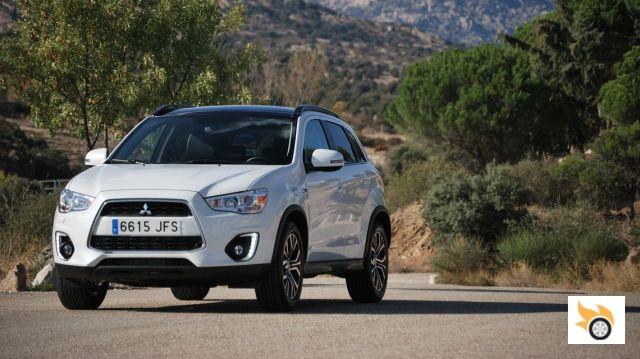Someone will probably think that this is a stock, heavy car and with that engine it can't go. With a kerb weight of 1,380 kg it's not the lightest on the block, but it's not a walrus either. Compared to its petrol equivalent, the 160 MPI, it's 95 kg heavier. The performance figures are more than adequate, 0-100 km/h in 11.2 seconds, and a top speed of 182 km/h. If you want more oomph you'll have to go for the 220 DI-D, which comes with all-wheel drive, automatic transmission, and full equipment (Kaiteki).
The ASX doesn't stand out for its performance, nor its interior space, nor the quality of its finishes, nor is it very expensive or very cheap, nor badly or very well equipped... It's a healthy middle ground in any sense. Within the competitive segment in which it is, it has positioned itself really well, and is by far the car that Mitsubishi sells best in our country. It sold 6,282 ASXs last year, which was 53% up on 2014, a significant growth.
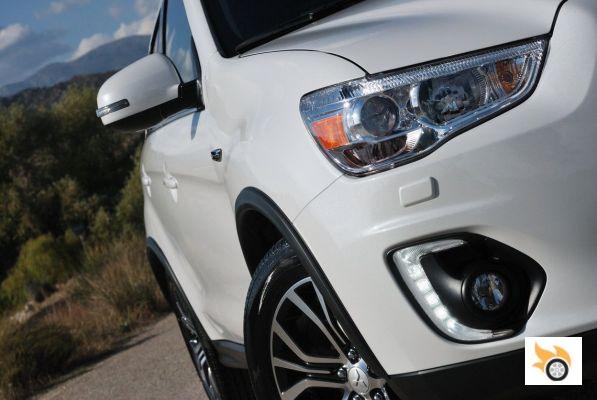
Design
Right now the ASX has some slight aesthetic tweaks compared to the model that started selling in 2010, and they can be confused relatively easily. The front grille is less imposing and shows less of that "jet-fighter" type of design (they called it that), it's like more refined, there's also less black plastic in sight. The LED daytime running lights are buckle-shaped, replaced a chrome trim in 2014, and surround the fog lights. On this model, the Kaiteki, the low beams are xenon, though the high beams remain halogen.
It has two French cousins, the Citroën C4 Aircross and the Peugeot 4008.
The 18-inch wheels were new last year for the mid and top models, as well as the black plastic protection that enhances the wheel arches more intensely. The test unit is fitted with 225/45 R18 Bridgestone Dueler H/P Sport tyres, which are obviously for tarmac use. There is an all-wheel drive version with this engine, but with a less abundant equipment, the Motion, for 2,200 euros more than its equivalent 2WD, and comes out to 200 euros less than the Kaiteki tested.
It has a more than sufficient ground clearance, 180 mm, considering the car we're talking about, a high passenger car. It has an angle of attack of 20 degrees, a forward angle of 19 degrees, and a departure angle of 32 degrees. It's not an off-roader, nor does it pretend to be, but it has a certain ease to drive off tarmac roads. Unlike other occasions, I haven't tested it in those circumstances, I drove it like any urban SUV, and it didn't get muddy at any time. It is equipped with a panoramic sunroof, and camouflages the roof rack bars by going all black.
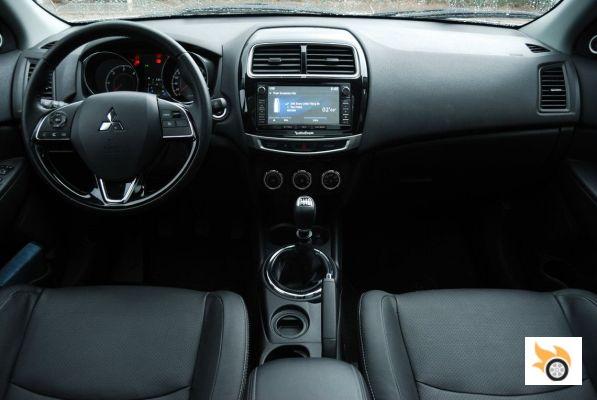
Cabin
Anyone who buys a car like this is looking for more space than in a compact, but in the ASX you won't notice a huge difference, apart from the slightly higher driving position. I don't think it's much bigger inside than a Lancer, although tall people can fit comfortably in the car if there are a maximum of four of them. The fifth passenger doesn't have much width to sit on, although the seat is usable due to its softness, even though it can be folded down. The headrest is just right for those over 1.7 meters tall, and the central tunnel is a little high.
Little has changed: steering wheel and central console; the rest is practically the same.
The cabin of the ASX is well built in general, although in the test unit I heard some noises that seem to come from the dashboard, may be a detail of the tested unit. Otherwise, no more crickets are apparent, and when the stereo with Rockford Fosgate speakers unleashes the watts, they don't vibrate the door panels annoyingly, just understandably. By the way, the stereo is the real deal (710 watts and nine speakers), you can understand by looking at the pictures of the trunk, with a huge bass box.
Almost all the plastics are hard as rocks, except for some lightly padded ones that are on the top and cross from side to side the dashboard. To be honest, some quality details are missing, such as rubber bottoms on the slides, or upholstery in the glove box or the center chest. In fact, in the central box, when we open it, we will see screws in sight. In that area is a power socket and a USB connector. If the lid is closed, the cable can easily be pulled out to charge a mobile phone outside the space. The glove box has a delayed opening, cooling, pen slot, and sufficient capacity.
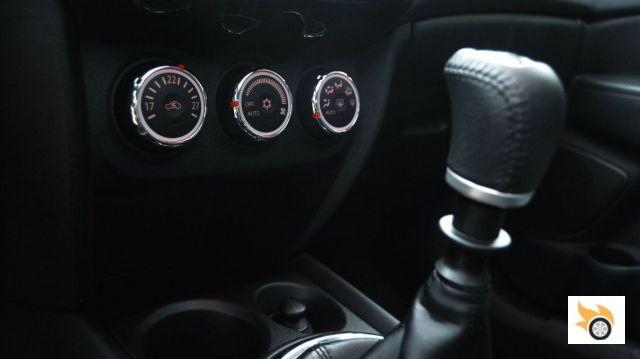
Let's continue, there are more details that detract a bit from the whole. A power cable comes out of the central mirror, which could have been concealed a little better. To the left of the dashboard there is a button that says "INFO", which toggles the functions of the on-board computer. It forces you to take your hand off the steering wheel, thank goodness it's not in the middle of the dashboard. The hole that would be occupied by the all-wheel drive selector, near the gearbox, is useless, I can only think of leaving a coin or two there.
Near the seatbelt hooks are the buttons for the seat heating, not very visible.
The automatic climate control, single zone, doesn't have a sad display, as in cars of the A or B segment. If we look at the front seats, it may seem that they lack lateral support. And so it is, in the curves hold little, and being leather and electrically adjustable I missed the lumbar reinforcement. The front doors have some holes a bit tight, and in the rear doors there are no holes at all. Only the storage compartments behind the front seats can hold objects in the back.
The sunroof lacks lighting in the rear of the car, which is partially compensated by the LED lighting that surrounds the contour of the roof, which is not practicable. I'm also not convinced that the accelerator pedal is a bit protruding, it would be better a board one. It's a pity, because the left footrest is huge, you could almost drive with clown shoes. In fairness it must be said that the driver's seat allows many adjustments between steering wheel, seats and seatbelt height, it's not going to be all bad things.
The main sources of noise are the tires and the air, the engine is not annoying until you go above legal speeds, ie, passing 3,000 RPM in a high gear. Overall it is very well isolated, it is not the typical annoying diesel, although it has some room for improvement. The noise issue is relative, the stereo can silence everything, you just have to choose good niggas to make those speakers work.
By the way, since I'm talking about the stereo, it's a double DIN with a 7″ folding touch screen, which uncovers an SD card reader and a CD optical disc reader. The operation is simple, too bad it's a bit slow to react and the interface is a bit old-fashioned. This model doesn't have any advanced connectivity solutions, it's stuck in the year it was first sold, 2010. When selecting reverse gear, we will see the image of the rear camera.
We finish this part with the trunk. It's not to throw rockets, has 416 liters, above a compact C-segment, but has no more space than a good sedan. By the way, the Lancer sedan had only 16 litres less boot space. If you remove the lower tray, you'll find a bit more space and the tools to repair a puncture, because it doesn't have a spare wheel. It has a hook on the left and lighting, although it doesn't do much.
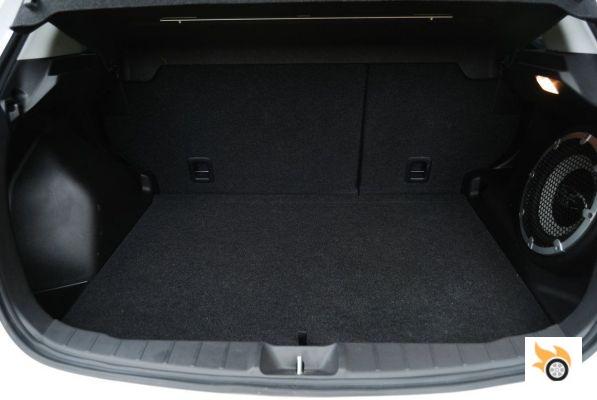
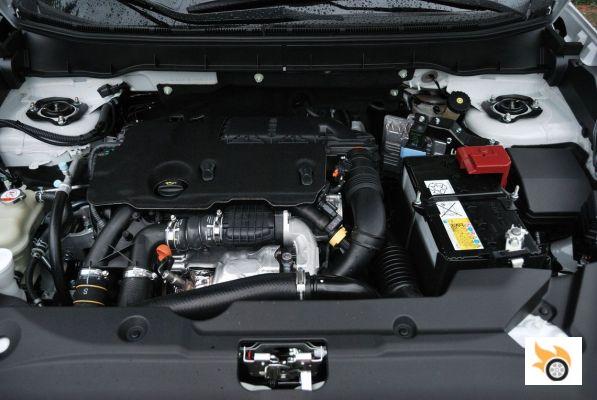
Technology
The ASX is based on the same platform as the Outlander and Lancer. The engine in this version, 160 DI-D, is the replacement for the previous 180 DI-D. Instead of using a Mitsubishi-sourced engine, it's PSA-sourced, with a reduction in displacement and just a couple of bhp less: 114 in total. Until I took a look at the data sheet I was convinced I was driving a 1.8, it pulls well and is properly insulated. Maybe I've only driven a few 1.6 HDi in the last 12 years?
It delivers a maximum torque of 270 Nm at 1750 RPM. The manual gearbox is a six-ratio, with a mechanical feel and very sharp shifting in the corridors. Those who like, as I do, to drive a stick with such a feel, will love it. In a Hyundai Tucson or a Nissan Qashqai you'll feel more isolation moving the lever. The Stop&Start system works more often than in several of its rivals, even when cold, although it lacks smoothness when stopping and starting the engine.
The engine change was made to comply with Euro 6 regulations. It has a fuel consumption of 4.6 l/100 km, a little more than the 180 DI-D, but still exempt from registration tax. In sixth gear at 120 km / h it rolls at about 2,500 RPM, a little high speed, but has the advantage that the engine generates more heat and in the long run should give fewer problems of anti-pollution systems. With this engine you can't opt for an automatic transmission.
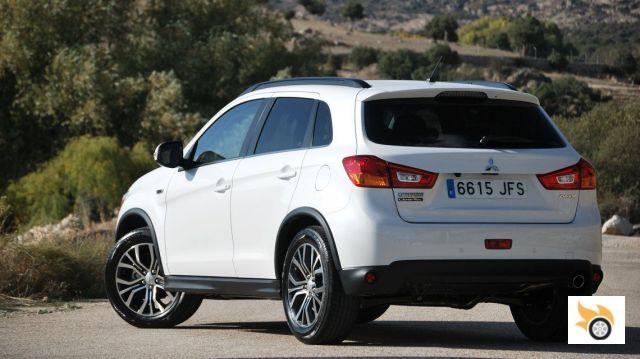
Driving
With 114 hp we will be able to drive it on almost all roads in Spain, even a little over the legal speed limits. Beyond that, you can't ask for anything more. For the type of car it is, I have not missed power, the chassis does not cry out for a more willing propellant. On top, it has a 2.3 of 150 hp (220 DI-D), a pity that is raised as a top of the range with a single version that has a surcharge of more than 5,000 euros for all-wheel drive and automatic transmission.
On paper, the 1.6 turbodiesel engine of PSA origin is slower than the 1.8 of Mitsubishi origin, something understandable by the reduction in displacement. For the overwhelming majority of the population it does what it has to do, and in a home measurement from 80 to 120 km / h in fourth gear it managed 9 seconds, which is not bad at all, almost like a compact car. I didn't notice that it was very heavy because of the 18 inch rollers.
If we do miles, the better, ask for a service every 20,000 km or a year.
On the other hand, it has a fairly contained consumption for its size and weight. You can get partial 4-5 l/100 km with little difficulty, in the total of the test was 5.5 l/100 km, at an average of 61 km / h. You can do 1,100 kilometers per tank, taking into account that it holds 60 liters. For those who like to fill up once or twice a month, in that sense, it doesn't disappoint. In any case, the 150 hp Outlander doesn't get much more than that - it makes do with 6.5 l/100 km.
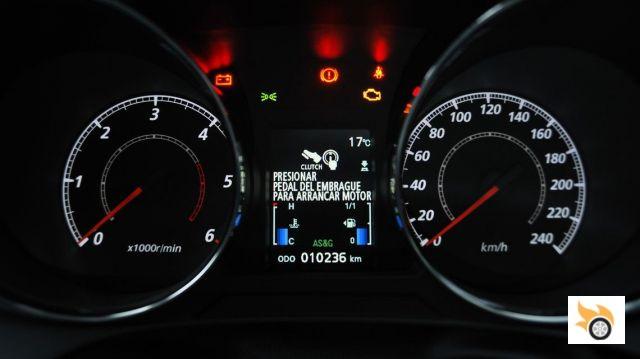
It's not easy to slide off the front axle, the engine doesn't have as much power, and in the Outlander that's more noticeable, with 110 Nm more torque. The power delivery is relatively smooth, but if we accelerate hard from low revs we will notice that pushes a lot at the bottom of the tachometer, but quickly deflates above. Nothing new on the front in this regard. The gears are not excessively long and the engine does not suffer.
The suspension, fully independent, has a reasonable fit between comfort and efficiency, received some tweaks with the restyling. It feels a little heavier than a compact, but it's not the typical SUV that you don't feel like driving around corners. It just lacks a bit of agility in changes of support, and a more precise and direct steering. If we want to speed up in the curves, it will tend to understeer, and if we are abrupt, we will receive abrupt corrections from the stability control. It allows some joy from time to time, although it is not a primary design objective.
Lacks any off-road assistance beyond traction control.
At this point we miss some driving assistance, such as lane departure warning or a fatigue detector, things that are more than invented already. On the other hand, if you want to drive in a more purist sense, you don't need to look much further. I was also very satisfied driving at night, the xenon headlights illuminate really well, although an LED matrix with front camera would do it better.
Conclusions
In short, we are facing a "round" car, which meets what is expected in the segment, without fanfare. Despite not being a friend of this type of car, it has happened to me as with the CX-5, it made me more bearable the week of testing because it is more oriented to drive it for those who appreciate that. Obviously I would like it more as a sedan, and with the Lancer body, but the market asks for what it asks for.
Don't blame the importer too much for bringing such a closed range, it suits what people are asking for: almost all front-wheel drive and diesel. The 115 hp petrol is an option for those who move little, or do not want to know anything about petrol. Being a naturally aspirated, you will have to play with the gearbox often, and if you want power with fewer gears, you will have to look at diesels.
Without having driven the 180 DI-D with the previous engine, I can't say that the 1.6 engine makes the situation worse or better, but I do think it's a very reasonable substitute. It makes sense to take advantage of the synergies with PSA, as from the same factory comes the C4 Aircross and 4008, which, by the way, are not so easy to see out there. People are preferring the original. The brand offers five years warranty without paying more, or 100,000 km, whichever comes first.
